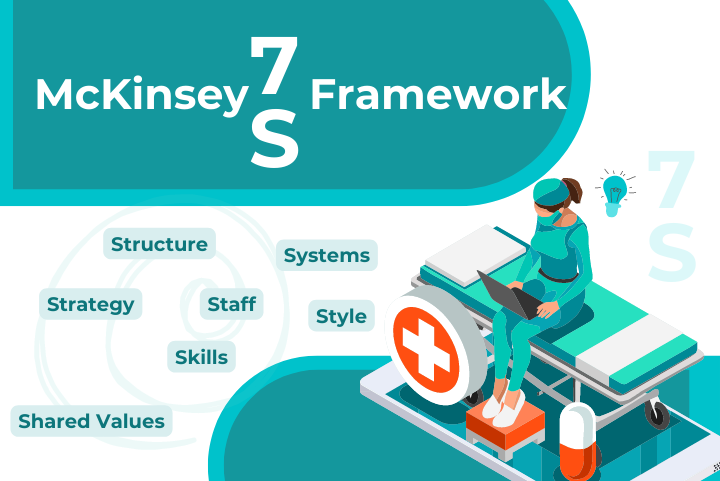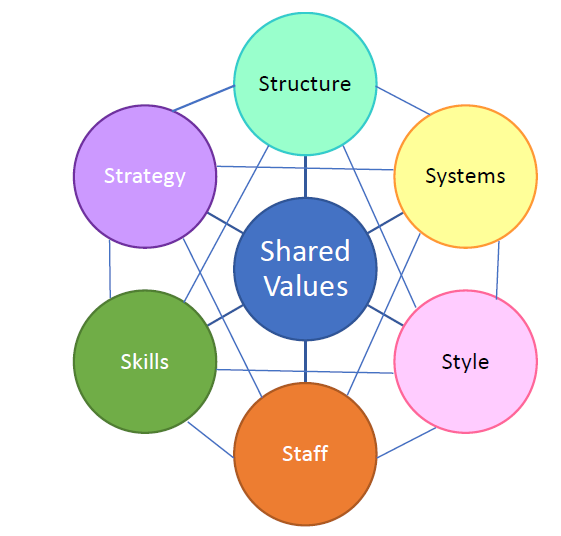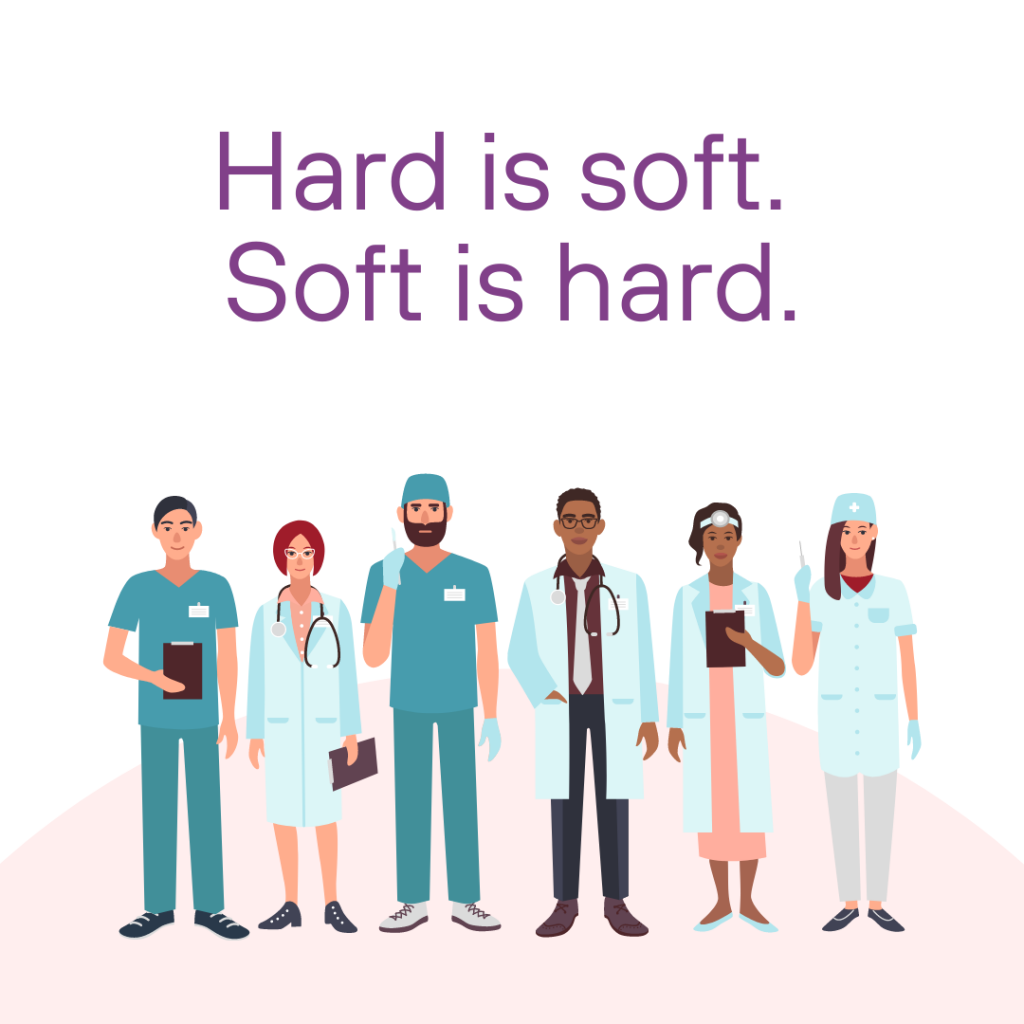by June Kaminski, RN MSN PhD(c)
Editor in Chief
CJNI was initiated by June Kaminski in 2006 when she was President-Elect of CNIA. She is currently Faculty and Curriculum Coordinator of a BSN Advanced Entry nursing program at Kwantlen Polytechnic University; Communications Officer, Webmaster, and former President of the Canadian Association of Nurses for the Environment and Editor in Chief of the Online Journal of Nursing Informatics. In 2012, June was honoured to receive the CASN and Canada Health Infoway’s inaugural Nursing Faculty E-Health Award 2012 in Ottawa Canada. She also won the Distinguished Teaching Award from Kwantlen Polytechnic University in 2016. She offers the Nursing Informatics Learning Centre with accredited CEU informatics courses.
Citation
Kaminski, J. (2022). Theory applied to informatics – The McKinsey 7-S Framework. Canadian Journal of Nursing Informatics, 17(1). https://cjni.net/journal/?p=9751

The McKinsey 7-S Framework was developed by Robert Waterman, Tom Peters, and Julien Phillips who were consultants working for McKinsey and Co. in the late 1970s with the help of Tony Athos and Richard Pascale. Since then it has been applied as a change management and holistic organizational quality model in many avenues of business and is “a framework introduced to address the critical role of coordination, rather than structure, in organizational effectiveness” (Bryan, 2008, p.1).
The framework or model emerged to go beyond the common focus on structure and strategy, to find the essence of organizational effectiveness. “The goal of the model is to depict how effectiveness can be achieved in an organization through the interactions of seven key elements – Structure, Strategy, Skill, System, Shared Values, Style, and Staff” (Corporate Finance Institute., n.d. p. 1). The seven elements were deliberatively chosen to create a unique model composed of all “S” words. “Tony was insistent that, corny as it appeared to be, we develop an alliterative model—find stuff that began with “Ss” in this case. In retrospect, it was a move of near genius” (Peters, 2011b, p. 2).
The model was visually presented using a circular configuration with Shared values in the centre, surrounded by the six elements of Structure, Strategy, Skill, System, Style, and Staff (Figure 1). The seven elements are also linked with interconnecting lines that show that each is equally valuable and that they all work together. As Tom Peters, one of the authors explained: “The shape of the “model” was also of monumental importance. It suggested that all seven forces needed to somehow be aligned if the organization was going to move forward vigorously—this was the “breakthrough” (a word I normally despise) that directly addressed Ron Daniel’s initial concerns that had motivated the project. As we put it in the 1980 Business Horizons article, “At its most powerful and complex, the framework forces us to concentrate on interactions and fit. The real energy required to re-direct an institution comes when all the variables in the model are aligned”” (Peters, 2011b, p. 2; Waterman et al., 1980, p. 26). The first public introduction to the model was through the Waterman et al. (1980) article in “Business Horizons, in its June 1980 issue, formally birthed the 7-Ss in an article by Bob Waterman, myself, and Julien Phillips titled: “Structure Is Not Organization.”” (Peters, 2011b, p. 1).
Figure 1: The McKinsey 7S Framework

Although the authors did not set out to create a change management model, the 7S Framework has been used to guide change in a variety of organizational contexts, including healthcare organizations since “the framework maps a constellation of interrelated factors that influence an organization’s ability to change. The lack of hierarchy among these factors suggests that significant progress in one part of the organization will be difficult without working on the others” (Bryan, 2008, p.1).
It is a model that is well suited to healthcare change, including information technology integration planning, since it guides users to apply a holistic approach to planning that considers all aspects of an organization from strategies to staff and their needs, to the shared values of all concerned. “This model is also a great reminder that change does not happen in a vacuum or in isolation; it can only happen within the wider context, and at the heart of it all is ‘Shared Values’ – the organisational culture, which can either hinder or enable change” (Change Quest, n.d., p. 3). “The model highlights that there exists a domino effect when any one element is transformed to restore effective balance. The central placement of shared values emphasizes that a strong change culture impacts all the other elements to drive change” (Malik, 2022, p. 1).
Wieberneit (2019) described how the 7S Framework could be applied to AI adoption. “What the model says, is that these seven factors need to be in alignment and even mutually reinforce each other in order for an organization to sustainably succeed when implementing a transformational change. Applying it to embedding AI in a business it immediately shows that purely looking at systems and skills is not enough. The paradigm shift, that the implementation of AI in a company is, needs to address the other five factors, too” (p. 1).
This holistic approach helps organizational teams to see the big picture, the gaps, the training and professional development needs, and the style that best suits them as they forge ahead. “The 7S model helps to analyse the current situation (point A) and the desired future situation (point B), and to identify gaps and inconsistencies between them. It is then a matter of adjusting and tuning the elements of the 7S model to ensure that the organisation works effectively and well once the desired endpoint has been reached” (Grant, 2008, p. 195; Think Insights, 2022; Jurevicius, 2021). To understand the 7S Model, one needs to explore the seven essential elements: Shared Values, Strategy, Structure, Style, Systems, Staff and Skills and how they interconnect.
Shared Values
Initially, the authors of this model called the inner element “Superordinate Goals” (Waterman et al., 1980) but in their 1982 book, In Search of Excellence they changed this element to “Shared Values” after much discussion and deliberation (Peters & Waterman, 1982). Shared Values was intentionally placed in the middle of the model configuration by the authors. “They are placed in the center of the model and interrelated with all the factors. Therefore, they depict the culture of the organization. They support long-term achievements and motivate employees to explore new, competitive arenas. Likewise, shared values provide employee engagement with the organization” (Alloc, 2018, p. 1).
This central position emphasizes that Shared Values are “the collective value system that is central to the organizational culture and represents the company’s standards and norms, attitudes, and beliefs. It’s regarded as the organization’s most fundamental building block that provides a foundation for the other six elements” (Creately Blog, 2021, p. 3) “that define an overall goal for all employees” (Chmielewska et al., 2022, p. 5). “While implementing a change, organizations expect a behavioral modification from their employees, which is only possible in a strong change culture and organizational values” (Malik, 2022, p. 3).
The authors discussed these points at length and described more indepth impacts of these shared values. “They are its main values. But they are more as well. They are the broad notions of future direction that the top management team wants to infuse throughout the organization. They are the way in which the team wants to express itself, to leave its own mark” (Waterman et al., 1980, p. 25).
Strategy
Strategy has long been a focus of virtually every organization’s development and/or change initiative: one that has served as the backbone and key tool for guiding efforts and goal attainment. Strategy is essentially, the map to achieve an organisation’s overarching aim to be successful and thrive. “What does a well-aligned strategy mean in the 7s McKinsey model? In general, a sound strategy is the one that’s clearly articulated, is long-term, helps to achieve competitive advantage and is reinforced by strong vision, mission and values. But it’s hard to tell if such strategy is well-aligned with other elements when analyzed alone. So, the key in the 7s model is not to look at your company to find the great strategy, structure, systems etc., but to look if it is aligned with other elements” (Jurevicius, 2021, p. 2).
This last point cannot be emphasized enough. When using the 7S model, all seven elements must be focused on as a cohesive unit. “The strategy element is a detailed plan that organizations create for successful change implementation and to gain a competitive edge. A well-crafted strategy is aligned with the other six elements of the 7-S model and is reinforced by a strong vision, mission, and values” (Malik, 2022, p. 3).
Strategy also colours and energizes the uniqueness of individual organizations or as its authors pointed out: “It is, or ought to be, an organization’s way of saying: “Here is how we will create unique value.”” (Waterman et al., 1980, p. 20).
When applying the 7S model to digital innovations, strategy guides several important questions that team leaders must ask. “In the fast paced world of digital healthcare, you’ve got to realize that you’re creating value beyond just having an app or big data platform. It’s how you reach and talk to your customers whether they’re doctors or patients or otherwise that gives you your competitive advantage. How are you reaching out to the innovators and early adopters who are going to be your startup’s champions?” (Abed, 2013, p. 1).
Structure
Structure is another fundamental element of organizational development and operations and is basically the outline of who reports to whom and is often visually represented in an organizational hierarchy chart.
“The structure is the organizational chart of the company. It represents how the different units and divisions of the company are organized, who reports to whom and the division and integration of tasks. The structure of a company could be hierarchical or flat, centralized or decentralized, autonomous or outsourced, or specialized or integrated. Compared to most other elements, this one is more visible and easier to change” (Creately Blog, 2021, p. 1).
Structure is a common element targeted during routine change initiatives. However, changing structure is often not successful in changing culture, values, or ways of interacting across an organization. In the context of informatics and technology adoption, structure is critical for providing accountability, responsibilities, and lines of communication across roles and departments. As Singh pointed out, “Most organizations use formal channels of communication. This results in choking of essential information giving rise to grapevines. The organizational structure has to be designed in a way that information is not choked” (2013, p. 43).
Style
In the 7S model, the style of leadership and how it influences the organizational culture is another important element of organizational effectiveness and change. “Style speaks to the example and approach that management takes in leading the company, as well as how this influences performance, productivity, and corporate culture” (Kenton, 2021, p.1). The way management makes decisions, interacts with personnel, initiates changes, establishes policies, guidelines, and rules all determine the inherent style element.
For instance, in an organization that values input and interaction with all employees, a culture of openness and collaboration will likely emerge. When proposing changes such as a new EHR integration, the organizational culture will become more receptive and supportive of the change if the management style invites inclusive communication and decision-making (Singh, 2013; Waterman et al., 1980). “Our proposition is that a corporation’s style, as a reflection of its culture, has more to do with its ability to change organization or performance than is generally recognized” (Waterman et al., 1980, p. 22).
Systems
Waterman, Peters and Phillips (1980) described the 7S systems element as the fundamental day by day functioning of an organization. “By systems we mean all the procedures, formal and informal, that make the organization go, day by day and year by year: capital budgeting systems, training systems, cost accounting procedures, budgeting systems. If there is a variable in our model that threatens to dominate the others, it could well be systems. Do you want to understand how an organization really does (or doesn’t) get things done? Look at the systems. Do you want to change an organization without disruptive restructuring? Try changing the systems” (Waterman et al., 1980, p. 21). “Managers should primarily focus on systems during organizational change” (Think Insights, 2022, p. 2).
Systems affect all people in an organization no matter what level of responsibility or role they function at. It is important that the interlaced systems in an organization are well planned and managed, since they influence “…daily procedures, workflow, and decisions that make up the standard operations within the organization” (Kenton, 2021, p.1). The 7S authors put particular emphasis on the critical role systems play in promoting effectiveness and advised leaders to pay close attention to how they shaped an organization’s systems. “To many business managers the word ” systems” has a dull, plodding, middle-management sound. Yet it is astonishing how powerfully system changes can enhance organizational effectiveness – without the disruptive side effects that so often ensue from tinkering with structure” (Waterman et al., 1980, p. 21).
Staff
The staff element in the 7S model focuses on an organization’s personnel, how many there are and what their roles are, how they are recruited and supported, what opportunities for training and development exist, how much they are paid, and what motivates them to do their best while at work (Creately Blog, 2021; Kenton, 2021; Singh, 2013). This element is fundamental to the smooth operation of any organization and often sets the tone for how workplace culture will evolve. It also introduces a complex element that takes insight and know-how to properly tap and bring out potential. “Staff (in the sense of people, not line/staff) is often treated in one of two ways. At the hard end of the spectrum, we talk of appraisal systems, pay scales, formal training programs, and the like. At the soft end, we talk about morale, attitude, motivation, and behavior” (Waterman et al., 1980, p. 23).
The important point of this element is to go beyond the notion of staff as hired help or cogs in the system and to value the uniqueness of each individual within the organization. “Considering people as a pool of resources to be nurtured, developed, guarded, and allocated is one of the many ways to turn the “staff” dimension of our 7-S framework into something not only amenable to, but worthy of practical control by senior management” (Waterman et al., 1980, p. 24).
Skills
The seventh and final element of the 7S framework is skills – meaning the actual current skills and competencies of staff/employees, as well as a look at the skills that need to be developed to allow an organization to grown or change. Like the other six elements, the skills element is an important and interdependent part of the model. As the model authors summarized, “We added the notion of skills for a highly practical reason: It enables us to capture a company’s crucial attributes as no other concept can do” (Waterman et al., 1980, p. 24).
The introduction or refinement of technology within an organization provides a classic example of how skills must be assessed, improved and/or replaced as new ways of doing things evolve. For instance, when healthcare organizations move from paper based documentation to electronic, all staff must develop new skills in order to use the system. An important part of this type of change is looking at what new skills must be cultivated and a means to support this skill development must be put into place (often by inhouse training) (Think Insights, 2022; Alloc, 2018). “Possibly the most difficult problem in trying to organize effectively is that of weeding out old skills-and their supporting systems, structures, etc. – to ensure that important new skills can take root and grow” (Waterman et al., 1980, p. 24). In order to transform organizations, communication must be motivating, supportive and compassionate to inspire staff to be open to the development of new skills with ample time and opportunity to do so in unhurried, and user-centric ways (Singh, 2013).
Hard and Soft Elements
An important deeper layer of the 7S Framework is the classification of the seven elements as either hard or soft. The three hard elements are the tangible, concrete, technical elements: Systems, Strategy and Structure (Figure 2). The four soft elements are viewed as social, intangible, abstract, fuzzy, and culture driven: Skills, Staff, Style and Shared values (Chmielewska et al., 2022; Kenton, 2021; Malik, 2022). “Change initiatives very often have more focus and effort put on the ‘hard’ more tangible elements, but the interconnectedness of this model shows that the ‘hard’ elements will not work unless the ‘soft’ elements are also addressed and aligned” (Change Quest, n.d., p. 3).
Figure 2: Hard and Soft Elements of the 7S Framework
Ironically, the 7S authors viewed these so-called soft elements as the most difficult to change or motivate. “I continue to say, over 30 years later, that the power of the 7-Ss and In Search of Excellence (Peters & Waterman, 1982) and my subsequent work can best be captured in six words: Hard is soft. Soft is hard. That is, it’s the plans and the numbers that are often soft (the sky-high soundness scores that the ratings agencies gave packages of dubious mortgages). And the people (staff) and shared values (culture) and skills (core competencies) that are truly hard—that is, the bedrock upon which the adaptive and enduring enterprise is built” (Peters, 2011a, p. 7). This observation provides sage direction when planning informatics related changes: work with the soft elements first, then plan the systems, strategy and structure for lasting and successful adoption and implementation.

“More importantly, it suggests the wisdom of taking seriously the variables in organizing that have been considered soft, informal, or beneath the purview of top management interest. We believe that style, systems, skills, superordinate goals can be observed directly, even measured – if only they are taken seriously. We think that these variables can be at least as important as strategy and structure in orchestrating major change; indeed, that they are almost critical for achieving necessary, or desirable, change. A shift in systems, a major retraining program for staff, or the generation of top – to – bottom enthusiasm around a new superordinate goal could take years. Changes in strategy and structure, on the surface, may happen more quickly. But the pace of real change is geared to all seven S’s” (Waterman et al., 1980, p. 26).
Application of the McKinsey 7S Model
It is quite plausible to follow the 7S model when planning any organizational change, including technology implementation. The first step is to identify which elements are well aligned and which are not. (Corporate Finance Institute., n.d.; Jurevicius, 2021). “You must identify which elements of the 7-S framework you need to realign to improve organizational performance or to maintain alignment and performance during other changes such as restructuring, process improvement, a corporate merger, new software implementation, or a leadership change” ” (Malik, 2022, p. 3).
Questions to Ask
“When embarking on any change initiative, you can use this model as a simple checklist.
Here are some useful questions to ask for each area:
Strategy: How does this change link up to the strategy, and how will it impact the strategy?
Structure: Will the organizational structure need to be changed?
Systems: Which systems across the organization will be impacted e.g. IT, HR?
Style: What style of leadership will be adopted to manage this change?
Staff: What general capabilities will people need after change is introduced?
Skills: What specific skills will people require to operate when change introduced?
Shared Values: What values / culture is necessary to make the change work?” (Change Quest, n.d., p. 3).
To summarize, the McKinsey 7S Framework provides a robust, holistic model that can be applied to comprehensively plan change and gauge organizational effectiveness. “At its most powerful and complex, the framework forces us to concentrate on interactions and fit. The real energy required to redirect an institution comes when all the variables in the model are aligned. One of our associates looks at our diagram as a set of compasses. “When all seven needles are all pointed the same way, ” he comments, ” you’re looking at an organized company ” (Waterman et al., 1980, p. 26).
References
Abed, S. (2013). The 7Ss of Digital Health Startup Success. HIT Consultant. https://hitconsultant.net/2013/03/06/the-7ss-of-digital-health-startup-success/
Alloc, I. (2018). Change Management Models -The McKinsey’s 7S Framework. LinkedIn. https://www.linkedin.com/pulse/change-management-models-mckinseys-7s-framework-isam-abbas-hr-manager/
Bryan, L. (2008). Enduring Ideas: The 7-S Framework. McKinsey Quarterly. https://www.mckinsey.com/business-functions/strategy-and-corporate-finance/our-insights/enduring-ideas-the-7-s-framework
Change Quest. McKinsey 7S change model. https://www.changequest.co.uk/wp-content/uploads/mckinsey_7s_model_v1.0.pdf
Chmielewska, M., Stokwiszewski, J., Markowska, J., & Hermanowski, T. (2022). Evaluating Organizational Performance of Public Hospitals using the McKinsey 7-S Framework. BMC Health Services Research, 22(1), 1–12. https://doi-org.ezproxy.kpu.ca:2443/10.1186/s12913-021-07402-3
Corporate Finance Institute. (n.d.) What is the McKinsey 7S Model? https://corporatefinanceinstitute.com/resources/knowledge/strategy/mckinsey-7s-model/
Creately Blog. (2021). The Easy Guide to the McKinsey 7S Model. https://creately.com/blog/diagrams/mckinsey-7s-model-guide/
Grant, P. (2008). “The productive ward round”: a critical analysis of organisational change. International Journal of Clinical Leadership, 16(4), 193–201.
Jurevicius, O. (2021). McKinsey 7S Model. Strategic Management Insights. https://strategicmanagementinsight.com/tools/mckinsey-7s-model-framework/
Kenton, W. (2021). McKinsey 7S Model. Investopedia. https://www.investopedia.com/terms/m/mckinsey-7s-model.asp
Malik, P. (2022). The McKinsey 7-S Model Framework, Explained. Whatfix. https://whatfix.com/blog/mckinsey-7s-model/
Peters, T. & Waterman, R. (1982). In Search of Excellence. HarperCollins.
Peters, T. (2011a). McKinsey 7-S Model: It continues to benefit leaders. Leadership Excellence, 28(10), 7.
Peters, T. (2011b). A Brief History of the 7-S (“McKinsey 7-S”) Model. Personal Blog. https://tompeters.com/2011/03/a-brief-history-of-the-7-s-mckinsey-7-s-model/
Singh, A. (2013). A Study of Role of McKinsey’s 7S Framework in Achieving Organizational Excellence. Organization Development Journal, 31(3), 39–50.
Sokol, R., Schuman-Olivier, Z., Batalden, M., Sullivan, L., & Shaughnessy, A. F. (2020). A Change Management Case Study for Safe Opioid Prescribing and Opioid Use Disorder Treatment. Journal of the American Board of Family Medicine: JABFM, 33(1), 129–137. https://doi-org.ezproxy.kpu.ca:2443/10.3122/jabfm.2020.01.190223
Think Insights (May 29, 2022) 7S: An organizational design framework from McKinsey. https://thinkinsights.net/strategy/7s-framework/
Waterman, R., Peters, T. & Phillips, J. (1980, June). Structure is not organization. Business Horizons. https://tompeters.com/docs/Structure_Is_Not_Organization.pdf
Wieberneit, T. (2019). Use the 7S Model for a Successful AI Transformation. CustomerThink. https://customerthink.com/use-the-7s-model-for-a-successful-ai-transformation/






